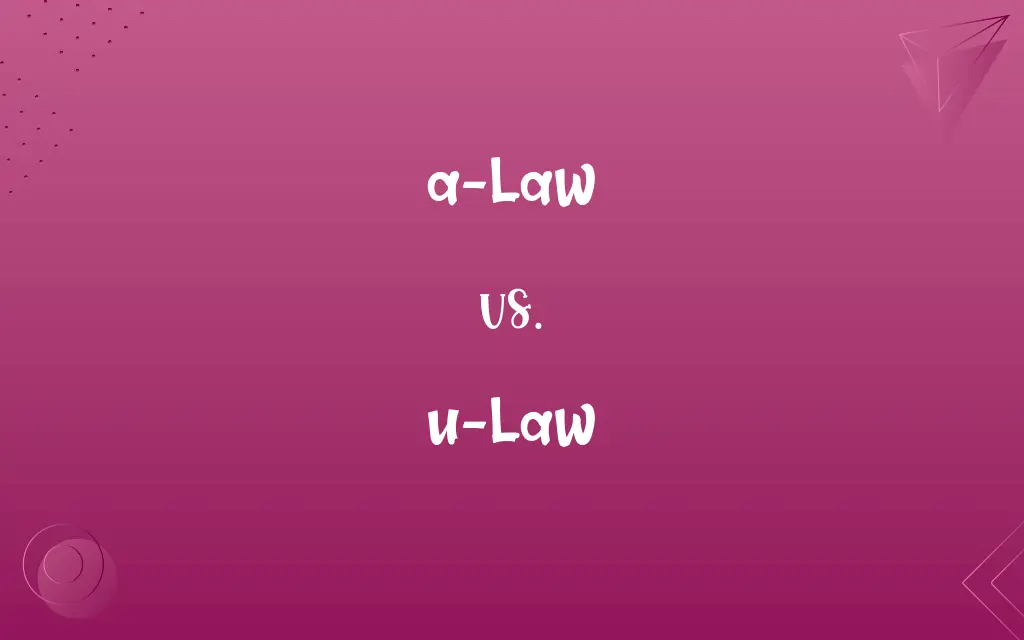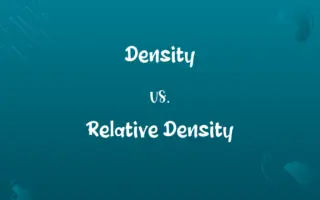a-Law vs. u-Law: Know the Difference

By Shumaila Saeed || Published on February 29, 2024
a-Law and u-Law are audio companding algorithms; a-Law is used in Europe/International standards, while u-Law is prevalent in North America.

Key Differences
a-Law is an audio compression scheme optimized for logarithmic transfer characteristics, primarily used in European telecommunication systems. Conversely, u-Law, also a companding algorithm, is employed mainly in North American and Japanese digital communication systems for effective dynamic range compression.
Shumaila Saeed
Feb 29, 2024
In a-Law, the dynamic range is compressed more at lower amplitudes than at higher ones, which enhances weak signals in noisy environments. u-Law, on the other hand, provides a slightly different companding profile, offering better resolution for stronger signals, thereby optimizing the signal-to-noise ratio.
Shumaila Saeed
Feb 29, 2024
a-Law has a 13-bit linear input which results in an 8-bit output, employing a more uniform quantization at lower levels. In contrast, u-Law, with its 14-bit input to 8-bit output conversion, prioritizes higher signal levels, giving them finer quantization.
Shumaila Saeed
Feb 29, 2024
The implementation of a-Law in international communication aids in standardizing audio signal processing, reducing discrepancies across different regions. u-Law’s implementation, particularly in North American telecommunication systems, aligns with the region-specific requirements for voice signal optimization.
Shumaila Saeed
Feb 29, 2024
a-Law’s algorithm features a compression ratio of 1:2 for small signals and 1:4 for larger signals. Meanwhile, u-Law applies a slightly more aggressive compression ratio, which can be advantageous in systems where bandwidth is a limiting factor.
Shumaila Saeed
Feb 29, 2024
ADVERTISEMENT
Comparison Chart
Signal Compression Ratio
1:2 for small, 1:4 for large signals
More aggressive than a-Law
Shumaila Saeed
Feb 29, 2024
Dynamic Range Compression
More uniform at lower levels
Finer quantization at higher levels
Shumaila Saeed
Feb 29, 2024
ADVERTISEMENT
a-Law and u-Law Definitions
a-Law
An audio compression technique for logarithmic amplitude levels.
To enhance weak signals, a-Law compression was applied.
Shumaila Saeed
Jan 15, 2024
u-Law
A method for compressing audio signals with logarithmic characteristics.
To improve the signal strength, the engineer recommended u-Law compression.
Shumaila Saeed
Jan 15, 2024
a-Law
Standardized in ITU-T G.711 for PCM audio coding.
Our telecom network conforms to the G.711 a-Law standard.
Shumaila Saeed
Jan 15, 2024
u-Law
Offers finer resolution for louder audio signals.
In our sound studio, we prefer u-Law for its handling of high-volume recordings.
Shumaila Saeed
Jan 15, 2024
a-Law
Utilizes a 1:2 and 1:4 compression ratio for audio signals.
For efficient bandwidth usage, our system switched to a-Law compression.
Shumaila Saeed
Jan 15, 2024
ADVERTISEMENT
u-Law
Employs a more aggressive compression than a-Law.
To save bandwidth, the network was configured to use u-Law compression.
Shumaila Saeed
Jan 15, 2024
a-Law
A companding algorithm used in European digital telephony.
The telephone system in France utilizes a-Law for signal processing.
Shumaila Saeed
Jan 15, 2024
u-Law
A North American standard for audio companding in telephony.
The conference call system uses u-Law for audio compression.
Shumaila Saeed
Jan 15, 2024
a-Law
Optimizes dynamic range in noisy environments.
A-Law enhanced the voice clarity in our high-noise factory setup.*
Shumaila Saeed
Jan 15, 2024
u-Law
Defined in ITU-T G.711 for Pulse Code Modulation (PCM) of voices.
Our telecom infrastructure adheres to the G.711 u-Law standard.
Shumaila Saeed
Jan 15, 2024
Repeatedly Asked Queries
Where is u-Law commonly used?
u-Law is predominantly used in North American and Japanese telecommunication systems.
Shumaila Saeed
Feb 29, 2024
Are a-Law and u-Law interchangeable?
No, they are region-specific and have different companding profiles.
Shumaila Saeed
Feb 29, 2024
What is a-Law?
a-Law is a European audio companding algorithm used in telecommunication systems.
Shumaila Saeed
Feb 29, 2024
What's the input/output conversion for a-Law?
a-Law uses a 13-bit linear input for an 8-bit output.
Shumaila Saeed
Feb 29, 2024
What does u-Law's conversion ratio look like?
u-Law converts a 14-bit input to an 8-bit output.
Shumaila Saeed
Feb 29, 2024
Can a-Law and u-Law be used globally?
They can, but it's more efficient to use the standard specific to the telecommunication system's region.
Shumaila Saeed
Feb 29, 2024
Why is u-Law preferred in North America?
u-Law is tailored to North American telecom standards, optimizing bandwidth and signal quality.
Shumaila Saeed
Feb 29, 2024
Are there any bandwidth advantages to using u-Law?
u-Law's aggressive compression can be advantageous in bandwidth-limited systems.
Shumaila Saeed
Feb 29, 2024
What's the advantage of u-Law?
u-Law offers better resolution for stronger signals, optimizing the signal-to-noise ratio.
Shumaila Saeed
Feb 29, 2024
How does a-Law compression work?
a-Law compresses the dynamic range, more at lower amplitudes, enhancing weak signals.
Shumaila Saeed
Feb 29, 2024
What role do a-Law and u-Law play in PCM?
They are used in Pulse Code Modulation (PCM) for compressing and decompressing audio signals.
Shumaila Saeed
Feb 29, 2024
Do a-Law and u-Law impact voice quality in telephony?
Both aim to optimize voice quality, but their effectiveness varies with signal strength and noise levels.
Shumaila Saeed
Feb 29, 2024
Is a-Law better for noisy environments?
Yes, a-Law is optimized for enhancing weak signals in noisy settings.
Shumaila Saeed
Feb 29, 2024
What is the main difference in compression between a-Law and u-Law?
a-Law compresses more uniformly at lower levels, while u-Law provides finer quantization at higher levels.
Shumaila Saeed
Feb 29, 2024
How does a-Law affect weaker audio signals?
a-Law enhances weaker signals, making them more distinguishable in the output.
Shumaila Saeed
Feb 29, 2024
What's the historical context of a-Law and u-Law?
Both were developed to efficiently transmit voice signals over digital telecommunication networks.
Shumaila Saeed
Feb 29, 2024
Are there any specific industries where one is preferred over the other?
The choice is more about regional telecom standards than industry-specific preferences; however, industries that deal with international communication might use both.
Shumaila Saeed
Feb 29, 2024
Can a-Law and u-Law be used in VoIP?
Yes, both are used in VoIP systems, depending on regional standards and requirements.
Shumaila Saeed
Feb 29, 2024
How do a-Law and u-Law compare in terms of global usage?
a-Law is more widely used internationally, while u-Law is specific to North America and Japan.
Shumaila Saeed
Feb 29, 2024
Is it possible to convert between a-Law and u-Law?
Yes, conversion is possible, but it may introduce slight quality loss due to different compression methods.
Shumaila Saeed
Feb 29, 2024
Share this page
Link for your blog / website
HTML
Link to share via messenger
About Author
Written by
Shumaila SaeedShumaila Saeed, an expert content creator with 6 years of experience, specializes in distilling complex topics into easily digestible comparisons, shining a light on the nuances that both inform and educate readers with clarity and accuracy.







































































